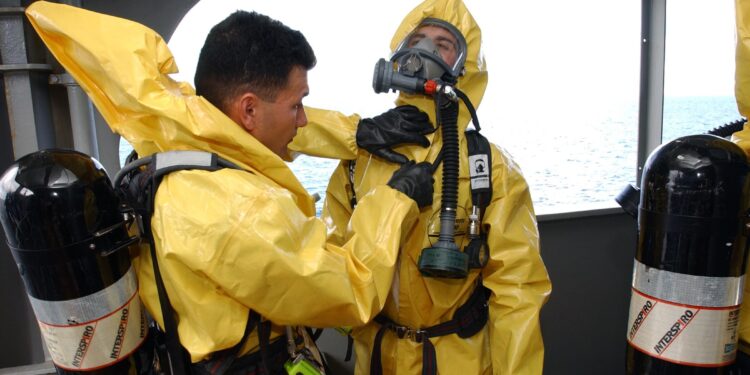United States and Kenya Forge Strategic Alliance to Counter CBRN Threats: Advancing Regional Security and Preparedness
In today’s volatile global landscape, the threat posed by Chemical, Biological, Radiological, and Nuclear (CBRN) hazards has become a pressing concern for nations worldwide. Recognizing the urgency of this challenge, the United States and Kenya have embarked on a collaborative journey to bolster their defenses against such dangers. This partnership not only aims to protect both countries but also seeks to enhance stability across East Africa. Through comprehensive training programs, intelligence cooperation, and resource sharing, this alliance represents a proactive approach toward mitigating risks that could otherwise lead to devastating consequences. This article explores the core elements of this collaboration, its strategic significance, and why preparedness is paramount in confronting evolving CBRN threats.
Strengthening US-Kenya Partnership to Counter CBRN Hazards
The United States and Kenya are intensifying their joint efforts in response to rising concerns over Chemical, Biological, Radiological, and Nuclear threats. Recent initiatives include coordinated training exercises designed to sharpen emergency response capabilities tailored specifically for CBRN scenarios. By integrating cutting-edge technology with robust intelligence exchange mechanisms between agencies from both countries, this partnership aims at creating a resilient defense network within the region.
Key focus areas of this collaboration include:
- Capacity Enhancement: Empowering local teams with specialized skills and resources necessary for effective management of CBRN emergencies.
- Information Exchange: Facilitating seamless communication channels between U.S. and Kenyan security entities for timely threat detection.
- Simulated Drills: Organizing realistic scenario-based exercises that prepare personnel for rapid deployment during actual incidents.
To guide these efforts systematically, a strategic framework has been established outlining clear priorities such as forming dedicated rapid-response units capable of swift intervention during crises while coordinating closely with international partners.
| Main Priority | Objective |
|---|---|
| Create Standardized Protocols | Formulate detailed action plans specific to various types of CBRN emergencies. |
| Modernize Equipment Inventory | Deploy state-of-the-art protective gear alongside advanced detection systems. |
| Cultivate Public Awareness | Launch educational campaigns aimed at informing communities about potential risks associated with hazardous materials. |
Comprehensive Strategy for Managing Chemical, Biological, Radiological & Nuclear Risks
In light of escalating global concerns surrounding CBRN agents’ misuse or accidental release—whether through terrorism or industrial accidents—the US-Kenya alliance has crafted an integrated strategy focused on resilience building across multiple fronts.
This multifaceted approach includes:
- Synchronized Training Programs: Frequent joint drills simulate real-world conditions ensuring readiness among military units as well as civilian first responders.[1]
- Tactical Intelligence Sharing: Enhanced data exchange protocols improve early warning systems by pooling surveillance insights from both nations’ agencies.
- Pioneering Research Initiatives: Investment into novel technologies facilitates faster identification methods along with efficient decontamination techniques.[2]
- Civic Education Drives:: Community outreach projects raise awareness about preventive measures individuals can take during potential exposure events.
The establishment of a specialized CBRN Rapid Response Task Force
(https://capital-cities.info/2025/02/09/africa/ivory-coast/abidjan/abidjan-on-high-alert-tension-rises-as-ship-carrying-hazardous-cargo-approaches-port/)
is central to operational readiness; equipped with advanced monitoring tools like portable spectrometers,
biochemical sensors, and drone surveillance platforms, this unit will be primed for immediate deployment when threats arise.
Its mandate covers several critical domains:Main Focus Area Aims Early Detection & Surveillance
Utilize cutting-edge sensor networks combined with AI-driven analytics platforms enabling swift identification
of chemical leaks or radiological anomalies.Emergency Mitigation Efforts
Coordinate rapid containment procedures minimizing impact on affected populations. Skill Development & Capacity Building
Conduct ongoing workshops enhancing expertise among first responders including medical personnel. Global Partnerships Expansion
Forge stronger ties with international organizations specializing in counter-CBRN operations facilitating knowledge transfer.</p> Building Regional Resilience Against CBRN Threats: Essential Recommendations
Given the increasing frequency of incidents involving hazardous materials worldwide — including recent reports indicating over 150 chemical-related accidents globally in 2023 alone[3], it is imperative that regional stakeholders adopt comprehensive strategies emphasizing cooperation across sectors.
First off,manual inter-agency coordination mechanisms must be strengthened. Seamless communication between local authorities,
national governments,and international bodies ensures unified command structures during crises.
Additionally,diligent investment into scenario-specific training programs, incorporating lessons learned from recent outbreaks like COVID-19’s biological challenges,
can significantly elevate preparedness levels among all emergency actors—from policymakers down through community volunteers.Equally important is fostering public engagement through targeted awareness drives educating citizens about recognizing signs related to chemical spills or radiological exposure symptoms.
Moreover,a commitment towards upgrading technological assets, such as deploying mobile detection labs equipped with next-generation sensors,
will empower frontline teams tasked with containment duties effectively.Outlined below are pivotal recommendations designed explicitly toward fortifying regional defenses against future occurrences:
Recommendation Description Strengthen Interagency Collaboration Establish routine multi-level coordination meetings promoting information flow among diverse stakeholders.
< tr >
< td >< b >Implement Regular Training Exercises
< td >Design immersive drills simulating varied types of chemical-biological-radiological-nuclear emergencies.< br /> < tr >< td >< b >Enhance Community Outreach Programs
< td>Create accessible educational content encouraging public participation in safety protocols.< br /> < tr >< td >< b >Invest In Advanced Technologies
< td>Pursue acquisition & maintenance plans prioritizing modern detection devices plus protective equipment.< br />Final Thoughts on US-Kenya Alliance: Pioneering Future Readiness Against CBRN Dangers
The emerging partnership between the United States and Kenya signifies more than just bilateral cooperation—it embodies an essential model demonstrating how nations can unite against complex security challenges posed by Chemical,Biological,Radiological,and Nuclear threats.As these two countries advance their shared objectives through continuous dialogue,training,and resource integration,the ripple effects promise enhanced stability throughout East Africa.This initiative highlights how foresight combined with collective action forms our best defense amid unpredictable global dynamics.In an era where unconventional hazards grow increasingly sophisticated,their united front serves as an inspiring example underscoring vigilance,isolationism’s antithesis,in safeguarding humanity’s future beyond borders.
[1] Source: Global Defense Review – “Joint Military Exercises Enhance Readiness” (2024)
[2] Source: International Journal on Emerging Technologies – “Innovations in Decontamination Methods” (2023)
[3] Source: World Health Organization Annual Report – “Chemical Incident Statistics” (2024)














